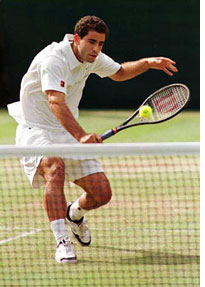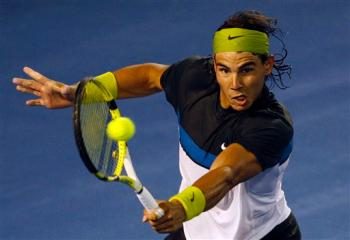Tennis has changed a lot in the last two decades, from the introduction of new strings, racquets, and other equipment that has made it easier to play tennis and make use of mediocre technique to still be able to play at a somewhat competitive level. Moreover, another implication is that it has made it more difficult to teach students the right technique and strategy in order to be able to be successful in the long run of a tennis career.

The changes are much more visible at the junior level… travelling with a lot of juniors to tournaments over the last several years, it been evident that since the innovations of new equipment, they are able to be more consistent and create effortless power, while using inadequate technique; furthermore, based on my experience this has been even more visible at girls junior tennis and younger divisions.
The impression or illusion in feeling like you are good because you are able to be consistent and hit winners at times, makes it difficult to convince young players that they need to make changes in order to succeed in the years to come in order to play at a college level or a have a chance to be a professional tennis player. Things change a bit as you watch the 16s and 18s boys and girls competitions…the better players clearly stick out with good technique, particularly in the boys divisions.
Based on my experience with juniors, girls (generally speaking) do not exhibit as good technique as the boys…and that is also prevalent at the professional level. Men’s technique is on average superior to that of women tennis players. To explore or elaborate on that further, there could be different reasons for that in my opinion:
• Women are not able to swing as fast at the opposite sex (strength); that leads to less power on their shots, more time to respond to their opponents shots, and it allows for easier timing (of hitting the ball). Consequently, great technique is not as imperative when one has a good amount of time to respond to a shot. However, when the pace picks us, windy conditions transpire, and/or fatigue or mental difficulties occur, the timing breaks down and subsequently an array of errors can happen. A great example is the 2012 men’s semi-final of Indian Wells – Nadal vs Federer. Federer has amazing strokes (technically) and very natural grips (more eastern); as a result he was barely bothered by the brutally windy conditions. Nadal on the other hand has technically fantastic strokes as well, but given the way he likes to strike the ball and his footwork, which requires greater physicality (when compared to Federer’s), he could not produce his usual shots under the weather conditions experienced that day. Furthermore, his grips being western create great spin on the ball and did not penetrate the court the same way that Federer’s flatter ball did through the wind. Please keep in mind that the comparison here is between two of the greatest players of all time. The take-away is that one can learn a lot about an individual’s game and ability to adjust to volatile environments…a player’s ability to adapt well to difficult conditions and perform consistently regardless of the precarious circumstances encountered, proves his/her core technical skills and mental strength. (If only the three surfaces used in the game – Grass, Clay, and Hard – were as different as they used to be, then things would be even more interesting on the tour…but that is whole different topic… ☺)
• Another reason could be that good coaches inherently focus their efforts more on the men at the inception of their young tennis careers than on women (for many potential reasons) leading to imbalanced exposure to good technique and tactic. A pertinent example is the 2013 Indian Wells women’s semifinal between Kerber and Wozniacki. Wozniacki was losing the match and being handled quite comfortably by Kerber…but when she started hitting “moon balls” she was able to work her way back in the match (moon balls are clearly not effective in men’s tennis). Kerber’s lack of aggressiveness and coming forward to take some of these balls out of the air, primarily led to her loss. Moreover, she did not feel comfortable with this strategy and let Wozniacki take her out of her comfort zone to ultimately steal the match from her. I often hear commentators say (regarding Wozniacki and other women players) that they need to be more aggressive, to come forward (to the net), and take more risk. In my opinion, if they could they probably would…technically these players have a limit to how hard they can hit the ball and consistently get it in, which is why they struggle greatly when playing against players who can be more aggressive than them on a more regular basis. Example, Saharapova having an effortless time with defeating Wozniacki in the 2012 Indian Wells women’s final.

This all leads back to the beginning of this blog on the tremendous importance of correct technique learned early in tennis players’ careers, particularly as it pertains to and affects their progression and development. Moreover, those tennis players who were once good or even the best in the younger age divisions slowly but surely are replaced in the older division rankings by players who have superior technique, have learned to control their game, and are able to hit the ball in specific/targeted directions with different spins and various paces. And because we discussed tennis equipment one last important take-away…it is helpful not to buy the most powerful racquet or get the string that creates the most spin as you learn to play tennis; you need to learn to feel and control the ball and this is difficult if done with equipment that does not provide you with accurate results when you make poor contact (with the ball) or hit the ball too hard and it still goes in. An adequate assessment, attainment, and utilization of proper equipment (specifically tennis racquets and strings) is instrumental in learning and applying the right technique in addition to getting a good “feel” for the game of tennis.
I look forward to replying to questions, hearing your comments, and learning about your experiences!
More to come…also, check out my Facebook and Twitter pages.
The end depends on the beginning…
Start your tennis lessons today, start the right way!
